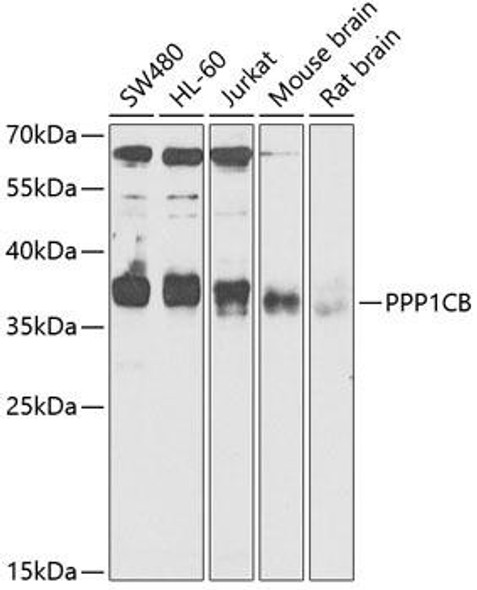| UniProt Protein Function: | PPP1CB: is a catalytic subunit of protein phosphatase 1 (PP1), a ubiquitous cytosolic serine-threonine phosphatase. Composed a catalytic subunit (PPP1CA, PPP1CB or PPP1CC) which is folded into its native form by inhibitor 2 and glycogen synthetase kinase 3, and then complexed to one or several targeting (or regulatory) subunits: PPP1R12A and PPP1R12B mediate binding to myosin; PPP1R3A, PPP1R3B, PPP1R3C and PPP1R3D mediate binding to glycogen; and PPP1R15A and PPP1R15B mediate binding to EIF2S1. PP1 is essential for cell division, plays critical roles in many cellular processes including glycogen metabolism, muscle contractility and protein synthesis, and is involved in the regulation of ionic conductances and long-term synaptic plasticity. Inhibits the synthesis of proteins involved in synaptic plasticity. Binds to the transcription factor cyclic AMP-dependent response element binding (CREB) and dephosphorylates it. May regulate chromatin condensation through regulation of histone H3 phosphorylation. Differentially expressed in gastric cancer. May participate in the neurodegenerative progress in Alzheimer's disease. Down-regulated in lung squamous cell carcinoma.Protein type: EC 3.1.3.16; EC 3.1.3.53; Motility/polarity/chemotaxis; Nucleolus; Protein phosphatase, Ser/Thr (non-receptor)Chromosomal Location of Human Ortholog: 5|5 B1Cellular Component: cytoplasm; focal adhesion; glycogen granule; nuclear chromosome, telomeric region; nucleus; protein phosphatase type 1 complexMolecular Function: myosin-light-chain-phosphatase activity; phosphoprotein phosphatase activity; phosphoric monoester hydrolase activity; protein binding; protein kinase binding; protein serine/threonine phosphatase activityBiological Process: circadian regulation of gene expression; entrainment of circadian clock by photoperiod; protein amino acid dephosphorylation; regulation of cell adhesion; regulation of circadian rhythm; regulation of glycogen biosynthetic process; regulation of glycogen catabolic process |
| UniProt Protein Details: | |
| NCBI Summary: | |
| UniProt Code: | P62141 |
| NCBI GenInfo Identifier: | 161484668 |
| NCBI Gene ID: | 19046 |
| NCBI Accession: | NP_766295.2 |
| UniProt Secondary Accession: | P62141,P37140, Q3TBE5, Q3TL90, Q542E7, Q8C285, Q9DBY2 |
| UniProt Related Accession: | P62141 |
| Molecular Weight: | 37,187 Da |
| NCBI Full Name: | serine/threonine-protein phosphatase PP1-beta catalytic subunit |
| NCBI Synonym Full Names: | protein phosphatase 1, catalytic subunit, beta isoform |
| NCBI Official Symbol: | Ppp1cb |
| NCBI Official Synonym Symbols: | 1200010B19 |
| NCBI Protein Information: | serine/threonine-protein phosphatase PP1-beta catalytic subunit |
| UniProt Protein Name: | Serine/threonine-protein phosphatase PP1-beta catalytic subunit |
| UniProt Synonym Protein Names: | |
| Protein Family: | Serine/threonine-protein phosphatase |
| UniProt Gene Name: | Ppp1cb |
| UniProt Entry Name: | |




